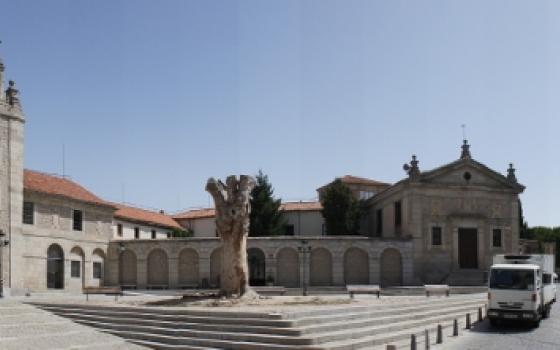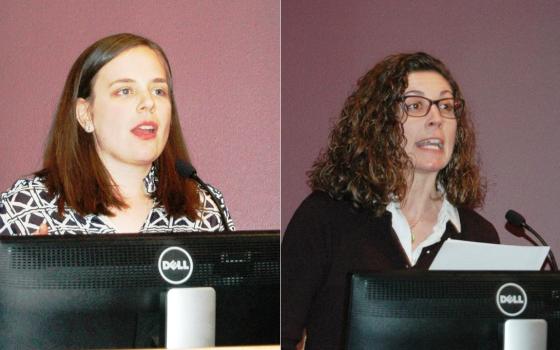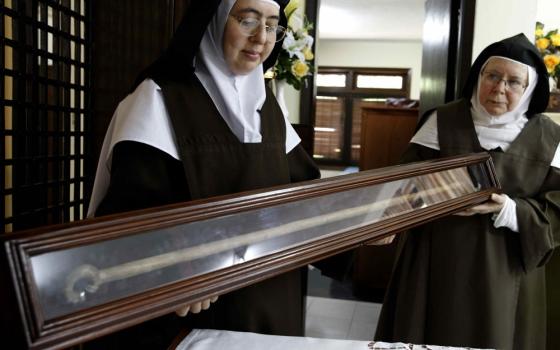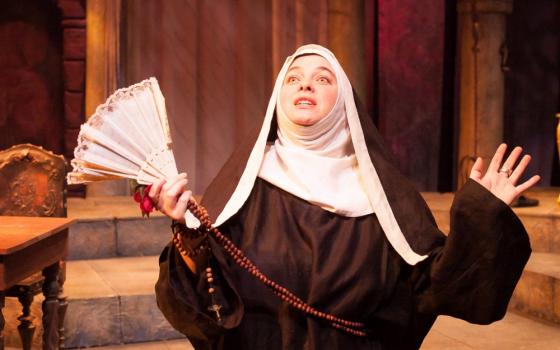Though she had been a well-known partier in her own times, St. Teresa of Avila would likely raise her dark eyebrows in surprise. This year, all over the world, people have been celebrating the 500th anniversary of her birth on March 28, 1515.
Birthday festivities for her certainly make Catholic sense. Teresa Sánchez de Cepeda y Ahumada was a profoundly influential Spanish mystic, a Carmelite reformer, the first woman doctor of the church, and the author of best-selling spiritual classics, including her masterpiece, The Interior Castle (1577).
Nonetheless, some wonder what a 16th-century mystic can say to 21st-century people of faith.
Theologians, Carmelite historians, and women who teach or act as spiritual directors insist that Teresa of Avila is a marvel. In talking about her impact, they seem to run out of superlatives.
“Teresa revolutionized spirituality by teaching that God deeply wants relationship with us,” said Gillian Ahlgren, professor of theology and director of the Institute for Spirituality and Social Justice at Xavier University in Cincinnati.
According to Ahlgren, author of several books on Teresa, the 16th-century Carmelite did what no one before her had ever thought of doing: “Teresa describes coherently a God who desires intimate companionship and collaboration from us and with us.”
When contacted about this article, Ahlgren was in Avila, Spain, leading a summer study group in the footsteps of Teresa.
“She taught (and modeled) what a genuine partnership with God looks like, and she affirmed that each one of us is called to that kind of partnership, no matter what our state or condition in life,” Ahlgren said. “In that sense, she was one of the most ‘self-actualized’ – to use a modern term – people in human history. She tried to share with people – especially women – how to move toward self-actualization.”
Sacred Heart Sr. Mary Frohlich said it was remarkable “the way Teresa gained her voice, a voice that was very influential in her own time and one that has continued to be influential.”
According to Frohlich, an associate professor of spirituality at the Catholic Theological Union in Chicago, the obstacles Teresa faced would have silenced anyone else.
“First of all, she was a woman,” Frohlich said. Even though Teresa deeply loved her father, Alfonso, and was his favorite among the family’s 12 children, women were totally dependent upon men in 16th-century Spain. It was no different in religious life. Women were to stay put and keep quiet.
Teresa also had to walk a very fine line in what she said and did because of her Jewish heritage, Frohlich added.
Spanish converts from Judaism to Catholicism – conversos – were never fully trusted by Catholics who could trace back their Catholicism for many generations. Prejudice against conversos was open and unrelenting. Teresa’s family did what they could to hide their Jewish roots.
“This constrained Teresa in many ways,” said Frohlich, who says Teresa’s writing hints at her Jewish ancestry. “She had to protect her nine brothers since it would have influenced [damaged] their careers. Teresa clearly was grieved that Jewish people were considered inferior.”
Frohlich and others suggest that these crucibles of persecution helped shape – and strengthen – Teresa. Over time, and especially after she felt Christ’s call to reform the Carmelites, she grew more sensitive to the heartaches and wounds of others. She recognized how social attitudes imprison people, and how much this displeases God.
“One of her greatest contribution to us, I think, is her Christian anthropology,” said Elizabeth Dreyer, professor of religious studies at Fairfield University. “That’s the way she understands the human person.”
In Teresa’s day, Dreyer said, Catholics whose families had been in the church for many generations were called “purebloods.” That should remind us, Dreyer said, “of other examples of religious or ethnic arrogance we’ve heard about through history.”
An authority on medieval theology and women’s spirituality, Dreyer said that Teresa had once been just as caught up in a superficial, social life as many other women of her day. After she learned to pray and had visions of Jesus, her view of the privileged world changed completely.
Enduring influence
Teresa’s search to do God’s will and the compelling way she taught others has moved many women. In Teresa, they have found a beloved teacher, a faithful friend, a life coach.
For Keith Egan, emeritus professor of theology at St. Mary’s College in Notre Dame, Ind., Teresa’s appeal to women is stunning – and it’s growing. “She has become an iconic woman,” said Egan, a lay Carmelite and former president of the Carmelite Institute.
“She was very funny, very down to earth and got all kinds of things done,” Egan said. “Teresa had friends everywhere and she knew what it was to be a friend. On the other hand, she was eminently contemplative.” That combination of being an activist and contemplative gets attention from women, he said.
In February and March, St. Mary’s held a series of talks celebrating Teresa’s fifth centenary. Egan and Dreyer were speakers, and it concluded with a panel of young women who explored “Teresa and Us: The Significance of Teresa of Avila for Young Catholic Women Today.”
Julia Feder, a postdoctoral theology research associate at the University of Notre Dame, said on the March 19 panel that Teresa taught her the meaning of humility in the Christian life.
“I have to confess that I’m not immediately attracted to humility,” she said. “It can suggest an image of a woman who is unsure of herself, who keeps her eyes on the ground and does not look others in the eyes directly.”
But as Feder studied Teresa’s message, she saw that “la Madre” had a balanced understanding of self-image that was indispensable for a 16th-century woman in a patriarchal culture.
“For Teresa, the journey toward union with God in prayer is also a journey in knowledge of the self,” Feder explained.
In The Interior Castle, Feder added, Teresa described different levels of knowledge of self and knowledge of God. They are described as rooms within a crystal castle. According to Teresa, some people live superficially. They live only in the outer courtyards of the castle, far from the innermost chamber. That innermost chamber radiates with God’s loving light and the realization that every person is made in God’s image.
When women see that what Teresa teaches about God explains their own dignity as human beings, their lives fall into place, Feder said. “To be truly within oneself, for Teresa, is to know oneself truly. To know oneself truly is to know oneself as one in whom God dwells.”
Katie Bugyis, another panelist at the St. Mary’s event, believes today’s women would applaud the way Teresa viewed women.
Her emphasis on a woman’s spiritual merit, gifts and talents pushed back against the norms of her day. For instance, most religious communities admitted only women whose families had plenty of money to contribute. However, in her letters, Teresa stressed the importance of admitting only nuns who had a true vocation.
According to Bugyis, who received a doctorate in medieval studies at Notre Dame, today’s women understand how hard it was for Teresa. Five centuries later, women still fight to be accepted on the basis of their gifts and talents.
“Believe me, mi padre,” Teresa once wrote to her confessor, “it is a pleasure for me every time I accept someone who brings in nothing and is received for love of God alone.”
Search for love
Recognizing Teresa’s tender love for others has also endeared her to many women. It made a huge difference in the life of Georgetown University’s Barbara Mujica, professor of Spanish and Portuguese language and literature. In 1997, as she wrote years later in Commonweal, her life was falling apart. Her younger brother had just died, and a lawsuit was dividing faculty members in her department.
Though she was an atheist, Mujica surprised herself by agreeing to make a five-day Ignatian retreat on campus. During the retreat, she reread The Interior Castle. As a professor of Spanish literature, she knew it well – as literature. Suddenly, it spoke to her heart. Teresa’s search for God had to do with the search for love.
After the retreat, as she wrote in 2010, “I lost myself in Teresa. I read everything she had written, as well as many studies of her work – not as a scholar, but as a spiritual seeker.”
Within a few years, Mujica was teaching courses on Spanish mysticism. She also went on to write a novel, Sister Teresa. By 2014, it had been adapted into a play, “God’s Gypsy.”
One scene from the play has had audiences laughing this year as the play toured. It presented Teresa and her friend Angelica trying chocolate, imported from the New World. The two nuns were thoroughly enjoying it, though they were aware that chocolate was about to be banned by the church because the authorities thought it was “too stimulating.”
Whether or not St. Teresa of Avila ever indulged in chocolate, Egan is quick to remind people that she relished fun, friendships and life’s good pleasures. When she was once criticized for enjoying partridge and an elegant dinner, Teresa famously shot back, “When you fast, fast; when you partridge, partridge!”
Some wonder what she would be like if she lived in our own times. Fans of Teresa don’t shy away from speculating.
“I think she might be one of the ‘Nuns on the Bus,’” mused Neomi DeAnda, assistant professor religious studies at the University of Dayton in Ohio.
DeAnda believes that the Nuns on the Bus are a modern example of “women who have deeply spiritual lives but also have the desire to create really positive change.”
“I’m not sure she would be out fighting for women’s ordination or gay marriage or other issues that some think are significant issues today, “ said DeAnda, who focuses on feminism, Latina theology, and the theological implications of breast milk. “I think she would be writing things that were progressive, but she had a distinctive view about how the Gospel called her. I’m not sure she would be revolutionary.”
Xavier University’s Ahlgren thinks that Teresa today “would be even more apostolic than she was in her own time.”
“We underestimate just how apostolic this ‘contemplative’ woman was. She was called a ‘gadabout’ (andariega) by some who thought that ‘good nuns’ were supposed to stay behind convent walls. She was – and is – an excellent model for balancing contemplation and action,” Ahlgren said.
“In my own work with Latina women who have survived domestic violence,” she added, “Teresa provides a powerful and trustworthy voice of authority, inviting us into relationship with a God who creates us with an inherent dignity that no one can take from us. It is easy to imagine Teresa working in places where lives and identities have been shattered by trauma and violence.”
[Catherine M. Odell is the author of Praying the Rosary for Intercession.]





